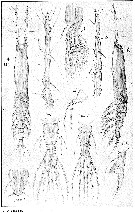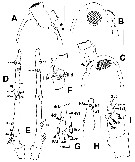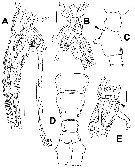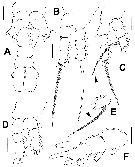|
|
 |
Fiche d'espèce de Copépode |
|
|
Monstrilloida ( Ordre ) |
|
|
|
Monstrillidae ( Famille ) |
|
|
|
Monstrilla ( Genre ) |
|
|
| |
Monstrilla leucopis Sars, 1921 (F,M) | |
| | | | | | | Syn.: | Monstrilla (?) danae T. Scott, 1900 (p.398, figs.F)
Monstrilla anglica : T. Scott, 1904 (p.246, figs.F);
No Monstrilla leucopsis : Wilson, 1950 (p.267) | | | | Ref.: | | | Sars, 1921 a p.15, (fig.F); Rose, 1933 a (p.342, figs.F,M);; Suarez-Morales, 2010 (p.56, Redescr. F, figs.F, Rem.); 2011 (p.9) |  issued from : G.O. Sars in An Account of the Crustacea of Norway, with short descriptions and figures of all the species, 1921a, 8. [Pl. VII]. Female (from Kvalø): Urs, urosome (dorsal). Nota: Eye inconspicuous, and replaced by an opaque whitish substance apparently answering to the ocular pigment. A1 5-segmented, none of the setae attached to the terminal segment ramified. Oral tubule small, occurring in front of the middle of the cephalic segment. natatory legs without any denticle inside the 2nd basal segment (Basis), exopod with terminal segment perfectly smooth. P5 gradually narrowed, with 2 apical setae, inner edge scarcely expanded. Male: Urs, urosome (ventral and lateral, respectively). Nota: A1 hinged. P5 pair reduced to 2 very small knob-like prominences, each tipped with a single slender seta. Abdomen 4-segmented, the 1st largest and produced below to a rather large and prominent copulative appendage of an oblong oval form and armed on each side with a straight rod-like spine.
|
 issued from : E. Suarez-Morales in Zootaxa, 2010, 2510. [p.58, Fig.1]. Female (from Kvalø, Norway: Sars Collection, Univ. of Oslo): A, C, habitus (lateral and dorsal; cuticular ornamentation arrowed). Scale bar 0.5 mm. Nota: Forehead with medial notch; sensilla not observed on cephalic area. A1 4-segmented (intersegmental divisions inconspicuous), relatively long, equal to 37 % of total body and 59 % of cephalothorax length; Oral papilla locared slightly less than 40 % of way back along ventral surface of cephalothorax. Ovigerous spines relatively short, 19.5 % of total body length and 32 % as long as cephalothorax.
|
 issued from : E. Suarez-Morales in Zootaxa, 2010, 2510. [p.59, Fig.2]. Female: A, cephalic area (lateral view), showing cuticular ornamentation and ventral processes (arrowed); B-C, same from other specimens; D, left A1 showing remains of armature; E, right A1; F, separate section of 3rd antennular segment; G, separate section of 4th antennular segment; H, separate section of distal area of A1; I, separate section with 1st and 2nd antennular segments. Nomenclature of setal elements follows Grygier & Ohtsuka (1995). Scale bars: A-C, F-I = 0.1 mm; D, E = 0.25 mm.
|
 issued from : E. Suarez-Morales in Zootaxa, 2010, 2510. [p.60, Fig.3]. Female: A, 5th pedigerous somite, genital double somite and 2 free urosomites (lateral); B-C, same, from other specimens; D, specimen depicted in B (dorsal); E, specimen depicted in B, P5 omitted (arrohead). Scale bars: A-E = 0.1 mm.
|
 issued from : E. Suarez-Morales in Zootaxa, 2010, 2510. [p.61, Fig.4]. Female: A, urosome and P5 (ventral); B, P1; C, P2; D, P3; E, 3rd endopodal segment of P3 (another specimen); F, endopod of P1 (another specimen). Scale bars: 0.1 mm. Nota: P5 medially conjoined at expanded base, unsegmented, each consisting of relatively large, strong outer (exopodal) lobe tapering distally; lobe armed with 2 equally long exopodal setae.
|
 issued from : E. Suarez-Morales in Zootaxa, 2010, 2510. [p.57]. Female: Armature formula of swimming legs. (Roman numerals = spines; Arabic numerals = setae).
| | | | | NZ: | 1 | | |
|
Carte de distribution de Monstrilla leucopis par zones géographiques
|
| | | | Loc: | | | NW Norway (Kvalø) | | | | N: | 4 | | | | Lg.: | | | (1044)* F: 2,84-3,26;
* caudal rami excluded. | | | | Rem.: | For Suarez-Morales (2010, p.62) , based on the general resemblance between M. conjunctiva and M. leucopis, several authors (Sewell, 1949; Isaac, 1974 and 1975) considered the latter as a possible junior synonym of the former. Male and female recorded from tropical Indian Ocean in the Nicobar Islands were questionably assigned to this species (Sewell, 1949). However, because of obvious biogeographic considerations (see in Suarez-Morales, 2001) it is clear that the Nicobar females reported by Sewell (1949) are not conspecific with M. conjunctiva from the Antarctic area (Sewell doubted his designation of these females as M. conjunctiva as it was called ''unknown'' in the text and witten as M. (?) conjunctiva only in the figure. The Nicobar females most probably represent an undescribed species. Unique characters that distinguish M. leucopis from all other known species of Monstrilla include the presence of modified setae on the endopods of legs 2-4: stout, thick-walled setal elements; this kind of modification has not been described previously among the Monstrilloida. Another interesting character is the reduction of the number of elements (4) on the 3rd endopodal segment of P1 (the usual pattern including 5 setae; this reduction was observed in at least two of the five specimens examined.
After Suarez-Morales (2010, p.66) specimens from from the Mediterranean Sea should be confirmed. Hence, the confirmed distribution of M. leucopis includes only Scotland and Norway. | | | Dernière mise à jour : 20/01/2015 | |
|
|
 Toute utilisation de ce site pour une publication sera mentionnée avec la référence suivante : Toute utilisation de ce site pour une publication sera mentionnée avec la référence suivante :
Razouls C., Desreumaux N., Kouwenberg J. et de Bovée F., 2005-2025. - Biodiversité des Copépodes planctoniques marins (morphologie, répartition géographique et données biologiques). Sorbonne Université, CNRS. Disponible sur http://copepodes.obs-banyuls.fr [Accédé le 29 décembre 2025] © copyright 2005-2025 Sorbonne Université, CNRS
|
|
 |
 |








